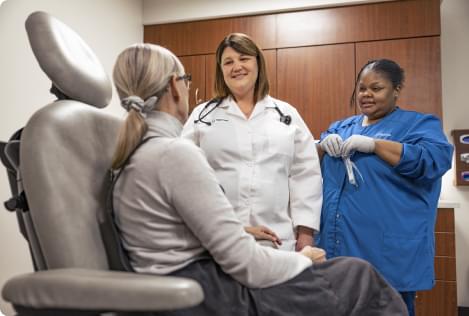| Study Name | Description | Trial Category | Trial SubCategory Sort descending |
|---|---|---|---|
| COG-ACNS0831 | Phase III Randomized Trial of Post-Radiation Chemotherapy in Patients with Newly Diagnosed Ependymoma Ages 1 to 21 years | Childhood Cancers | Glioma |
| COG:ACNS1123 | Phase 2 trial of response based radiation therapy for patients with localized central nervous system Germ Cel Tumors | Childhood Cancers | Tumor |
| COG-AREN03B2 | Renal Tumors Classification, Biology, and Banking Study | Childhood Cancers | Tumor |
| COG-AHOD1331 | A randomized Phase III Study of Brentuximab Vedotin (SGN-35, IND # 117117) for Newly Diagnosed High-Risk Classical Hodgkin Lymphoma (cHL) in Children and Adolescents | Childhood Cancers | Lymphoma |
| ESsCAPE | The main objective of the trial is to assess the efficacy and safety of the drug trimodulin as adjunctive treatment to standard of care compared to placebo plus standard of care in adults hospitalized with severe community-acquired pneumonia on invasive mechanical ventilation. | Pulmonary | Respiratory |
| Improving Continuous Positive Airway | Improving Continuous Positive Airway Pressure Adherence in Patients with Obstructive Sleep Apnea: Impact of Patient and Family Engagement (Improving CPAP Adherence | Pulmonary | Respiratory |
| ANT-010/Lilac | A study to evaluate the effect of the experimental drug abelacimab relative to placebo in subjects with atrial fibrillation/flutter (AF) who are not treated with oral anticoagulants because they have been deemed by their responsible physicians or by their own decision to be unsuitable for currently available oral blood thinners. | Heart & Vascular | Atrial Fibrillation |
| Librexia AF | The purpose of this research study is to compare the effects of an experimental drug, milvexian, to the comparator drug, apixaban, to determine if it is safe and useful in reducing the risk of stroke and blood clots outside the brain (non-central nervous system (CNS) systemic embolism) in participants with atrial fibrillation. | Heart & Vascular | Atrial Fibrillation |
| Real AF | Real-world Experience of Catheter Ablation for the Treatment of Symptomatic Paroxysmal and Persistent Atrial Fibrillation Using Novel Contact Force Technologies: REAL AF Registry | Heart & Vascular | Atrial Fibrillation |
| Bayer Oceanic AF | The main purpose of this study is to collect more data about how well asundexian works to prevent stroke and systemic embolism and how safe it is compared to apixaban in people with atrial fibrillation and at high risk for stroke. The study treatment, asundexian, is a new type of anticoagulant currently under development to provide further treatment options. The way it works, it aims to further improve the standard of care with regard to the risk of bleeding. | Heart & Vascular | Atrial Fibrillation |
| Champion AF | The primary objective of this study is to determine if left atrial appendage closure with the WATCHMAN FLX device is a reasonable alternative to non-vitamin K oral anticoagulants in patients with non-valvular atrial fibrillation. | Heart & Vascular | Atrial Fibrillation |
| V-Inception | A randomized, controlled, multicenter, open-label trial comparing a hospital post-discharge care pathway involving aggressive LDL-C management that includes inclisiran with usual care versus usual care alone in patients with a recent acute coronary syndrome (VICTORION-INCEPTION) | Heart & Vascular | Lipid Management |
| APEC14B1 EveryChild | A Registry, Eligibility Screening, Biology and Outcome Study | Childhood Cancers | Registry |
| Portico NG | This is a study of an updated Portico Valve for TAVR. | Heart & Vascular | Structural Heart Disease |
| Amulet | Patients will have nonvalvular atrial fibrillation. This irregular beating of the heart leads to a slowing of the blood flow in the upper chambers of the heart. In the left upper chamber, there is a small pouch called the left atrial appendage (LAA). Slowing of blood, especially in the LAA, may cause blood clots to form. Blood clots can move from the LAA and travel to the brain, causing a stroke or transient ischemic attack (TIA), also called a mini-stroke. These blood clots can also travel to other parts of the body and block blood vessels. The Amulet device could be beneficial because it may lower the chance of a new blood clot forming and moving from the heart’s LAA to other parts of your body. | Heart & Vascular | Structural Heart Disease |
| PFO Occulder (PAS) | The purpose of this research study is to evaluate the commercially available AmplatzerTM PFO Occluder and AmplatzerTM TalismanTM PFO Occluder in preventing another stroke by closing patients patent foramen ovale (PFO). | Heart & Vascular | Structural Heart Disease |
| S1925 | The purpose of this study is to compare early intervention with Venetoclax and Obinutuzumab vs delayed therapy in newly diagnosed asymptomatic high0risk patients with Chronic Lymphocytic Leukemia (CLL) or Small Lymphocytic Lymphoma (SLL). You must have been diagnosed with CLL or SLL within the last 12 months. | Cancer | Hematology |
| S1703 | This study is looking at overall survival or patients monitored with serum tumor markers veruss usual care. You must be diagnosed with metastatic hormone receptor positive breast cancer. | Cancer | Metastatic Breast |
| EAY191-N2 ComboMATCH | This study is for people diagnosed with hormone receptor positive breast cancer that has spread. A NF1 gene mutation must exist. | Cancer | Metastatic Breast |
| Arrhythmia Detection After Myocardial Infarction (AID-MI) | This study will evaluate the use of an insertable cardiac monitor in patients following an acute myocardial infarction (heart attack) to determine if cardiac monitoring results in more rhythm-related findings that change management compared to standard of care post heart attack management in patients who do not receive the insertable cardiac monitor. | Heart & Vascular | Cardiac Arrhythmia |
| Sync AV | This is a new CRT with optimization turned on or off. | Heart & Vascular | Cardiac Arrhythmia |
| Aveir DR | The objective for this study is to confirm the safety and effectiveness of the Aveir LP (Leadless Pacemaker) System in a subject population indicated for a dual chamber pacemaker. | Heart & Vascular | Cardiac Arrhythmia |
| Node X | Participants must have participated in a prior study with the investigational drug etripamil (the NODE-301, NODE-302, or NODE-303 study). The study is being done to determine the safety of etripamil 70 mg for the treatment of multiple episodes of PSVT in an at-home setting. | Heart & Vascular | Cardiac Arrhythmia |
| PPP/PAN/PSR | This study is a registry study. The purpose is to collect information over time about how Medtronic products are working and/or the outcome of the treatment. The registry will be used to support post-market surveillance activities and post-approval studies (e.g., to collect safety and performance information). In addition, it will be used to obtain clinical evidence for the development and improvement of medical devices, therapies, device guidelines, patient services/solutions and provide clinical data to support health economics and clinical outcomes research. The registry is not an experimental clinical study. | Heart & Vascular | Cardiac Arrhythmia |
| Iocyte Faraday STEMI drug | The purpose of this study is to evaluate the efficacy and safety of the study drug vs placebo in subjects with an anterior ST-elevation myocardial infarction (STEMI) undergoing primary percutaneous coronary intervention (pPCI). | Heart & Vascular | Heart Failure |
| Amgen Ocean(a) | The primary objective of this study is to compare the effect of treatment with olpasiran, to placebo, on the risk for coronary heart disease death (CHD death), myocardial infarction, or urgent coronary revascularization in participants with atherosclerotic cardiovascular disease (ASCVD) and elevated Lipoprotein(a). Patients must have a Lp(a) value of ≥ 200 nmol/L during screening. | Heart & Vascular | Cardiovascular Disease |
| Complete TAVR | The purpose of this study is to determine whether restoring blood flow to all blocked or narrowed arteries via percutaneous coronary intervention (PCI) using coronary stents is better than treating the coronary artery disease (CAD) with medications in patients with CAD who had successful transcatheter aortic value replacement (TAVR) with a balloon expandable heart valve. The study will also compare measurements of hemodynamics (blood flow and blood pressure) that are taken during on-table procedures (TAVR and PCI) with those taken by echocardiography (heart ultrasound). | Heart & Vascular | Cardiovascular Disease |
| Rethink Reflux Registry | The purpose of this study is to gather information about how the LINX device works over an extended period in people with GERD (gastric esophageal reflux disease). | Surgery | GERD (Gastro Esophageal Reflux Disease) |
| Amplitude | This research study is a way to find out if the Study Drug is safe and if it works to help people with APOL-1 mediated Chronic Kidney Disease. | Nephrology | Proteinuric Kidney Disease |
| CREST 2 LOE | Long-Term Observational Extension of Participants in the CREST-2 Randomized Clinical Trial (C2LOE) | Heart & Vascular | Carotid Stenosis |
Unsupported Browser! This website will offer limited functionality in this browser. We only support the recent versions of major browsers like Chrome, Firefox, Safari, and Edge.


